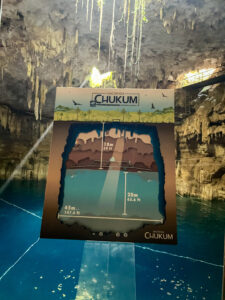
If you’ve ever seen an inland photo of the Yucatan Peninsula, it was probably of Chichen Itza. These Mayan ruins are considered one of the New Seven Wonders of the World and are one of the most-visited sites in North America. As with all wildly popular things, people’s opinions about the place vary greatly. I heard from some people that Chichen Itza was one of the most spectacular things they’ve ever seen. From others, I heard it was an overcrowded and over-hyped waste of time. I’d waited until just a few days before my Mexico trip ended to finally go see for myself.
Though there are a lot of organized tours to Chichen Itza from both Cancun (about 2.5 hours away) and Merida (a little less than 2 hours away), the closest town is Valladolid (about half an hour away). Most people visit Valladolid for just a few hours as part of their day tour to see Chichen Itza and a nearby cenote, but some people decide to spend a night so they can get to Chichen Itza before the buses arrive from the bigger cities. It’s a much smaller percentage of people who realize that Valladolid is a destination in its own right and well worth visiting for a few days.

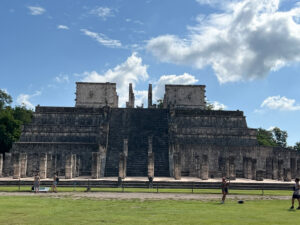
I spent 4 nights in Valladolid (which I’ll write about in my next blog post), and on one of my days, I took an organized tour to Chichen Itza with a local tour company advertised by my hostel called Premier Adventures. You can get to Chichen Itza on your own quite easily (and cheaply) from Valladolid, but the reason I chose the organized tour was because it included a visit to a cenote that would have been hard to get to on my own.
Our mini-bus left at 7:30am from the main plaza in Valladolid, and we arrived at Chichen Itza right after it opened. This is 100% what I recommend. If you’re in Merida or Cancun, this will mean leaving at 5:00am, yes. But I’m telling you it’s worth doing to get there at opening time. I’d heard so many horror stories about how crowded Chichen Itza gets. I’d seen photos of El Castillo (also called Kukulkan Pyramid—the main pyramid) with so many people surrounding it that it looked like a music festival. All the advice I read online said that arriving as early as possible was the best way to avoid the largest crowds.
My tour included our entrance tickets, so we were able to wait for just a few minutes as our guide collected the tickets for us, then we were able to skip the lines and go right inside. And I was surprised to see that it wasn’t crowded at all. It was maybe 8:30am, and there were several tour groups like ours scattered around, but the space is so large that half a football field could have sat between us and some of the other groups. I would go so far as to say it was… quiet—a word that seems unbelievable even as I type it.
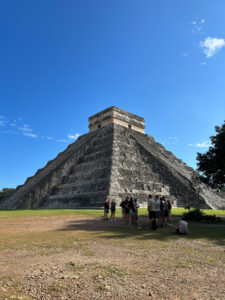
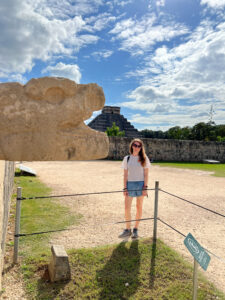

The only other Mayan ruins I’d visited were at Uxmal, which was nestled into gentle hills and forests. Chichen Itza felt entirely different. There were trees around the edges of the site, but the football field-sized space in the center of the ruins where the pyramid sits is completely flat with no trees. The way the pyramid rises from the nothingness around it makes it appear even grander. Like the pyramid at Uxmal, El Castillo responds with a Mayan bird chirp when you clap your hands in front of it.
Our tour guide did an excellent job of explaining the history of the place. He explained that Chichen Itza isn’t the most famous because it’s the largest or best preserved or most impressive; rather it’s the most famous because it’s the most important, historically and culturally. The name Chichen Itza means “the mouth of the well of the god of water,” and the main pyramid is built over an ancient and sacred cenote. The pyramid has 365 steps to the top to represent the calendar. The Mayan calendar is still one of the most accurate calendars in human history, and the Mayan people’s understanding of astronomy was astonishing.
What I hadn’t realized was how massive the rest of the grounds would be. We were given a lot of free time to explore on our own, but it would have taken hours to explore everything. Smaller ruins wove into the forest on the edges of the grounds, and craft and souvenir vendors began setting up tables around the tree line shortly after we arrived (Can someone explain why they allow them inside??). By the time we left, the crowds had arrived in full force. There were dozens and dozens, maybe 100, tables selling souvenirs. There were quadruple the number of people inside than when we arrived. The line to get in must have been an hour long. I cannot emphasize enough arriving when the ticket booth opens. I really loved Chichen Itza, and I am not sure if I would have felt the same if I’d been surrounded by mobs of people under the unforgiving midday.

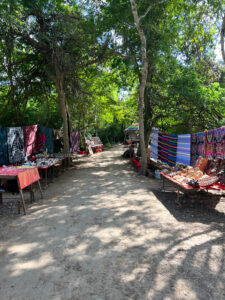
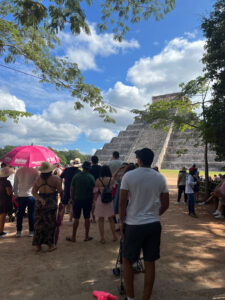
After Chichen Itza, we drove to a cenote called Chukum, and it may have been my favorite of all the cenotes I visited. The cenote was deep in an underground cave, but the sun shown through a small hole in the top like a bright spotlight. It was huge, and the water was nearly 70 feet deep. We were the only group there, so we had the place almost entirely to ourselves. I never would have known to pick this cenote on my own, and this alone made the tour feel well-worth it.
The facilities at Chukum were some of the best I saw at any cenote. The bathrooms stalls were separate from the changing rooms, which was so much more convenient. All the facilities were incredibly clean. And there was a very tasty all-you-can-eat buffet.
My favorite friend of the day was the only other solo traveler on my tour—a middle-aged woman named Miriam from Estonia. She’d been on a group trip in Central America, but she’d decided at the last minute to extend her trip and keep traveling solo through more of the Yucatan Peninsula. People like Miriam are so inspiring to me. Even though she might be my mom’s age, it hasn’t even occurred to her to NOT solo travel. I feel that in the United States, the older a person gets, the more outlandish solo travel (or really doing ANYTHING solo) seems. If Miriam were asked why she was solo traveling, I read her to be the kind of person who would stare at you blankly and say, “Why wouldn’t I?” And she would really expect you to answer.
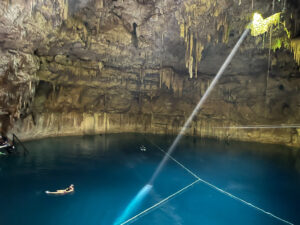

Something I noticed throughout my entire time in the Yucatan was a lack of American tourists. It seemed as though every tourist I met was European or Australian. I met a couple of American solo travelers in my hostel in Cancun, and I met a married couple from the US traveling together in Merida, and that was it. When Miriam and I were chatting with our guide/bus driver, I asked him why he thought this was. He said that from the handful of years he’s done this, he’d estimate that 85% of his guests are European. He smiled at me as he said, “It’s cause all the Americans are in the resorts.” Miriam said, “I stayed in one of those for a couple nights. It felt like a Soviet camp.” She wasn’t trying to be funny, but I laughed so hard I ached.
Our tour price included our transportation, our driver/guide, the guide at Chichen Itza, snacks, all the (cold) bottled water we wanted (It was late November, and I can’t describe to you just how hot it was.), the Chichen Itza ticket, our cenote ticket, and an all-you-can-eat buffet. At about $106 US dollars, it was one of the most expensive tours I did in Mexico, but I thought it was well worth it, and I don’t think I could have done all the same things on my own for much, if any, cheaper. I highly recommend Premier Adventures if you’re in Valladolid. And I can confirm that Chichen Itza is, in fact, worth visiting—don’t let any grumpy and overheated people tell you otherwise.
